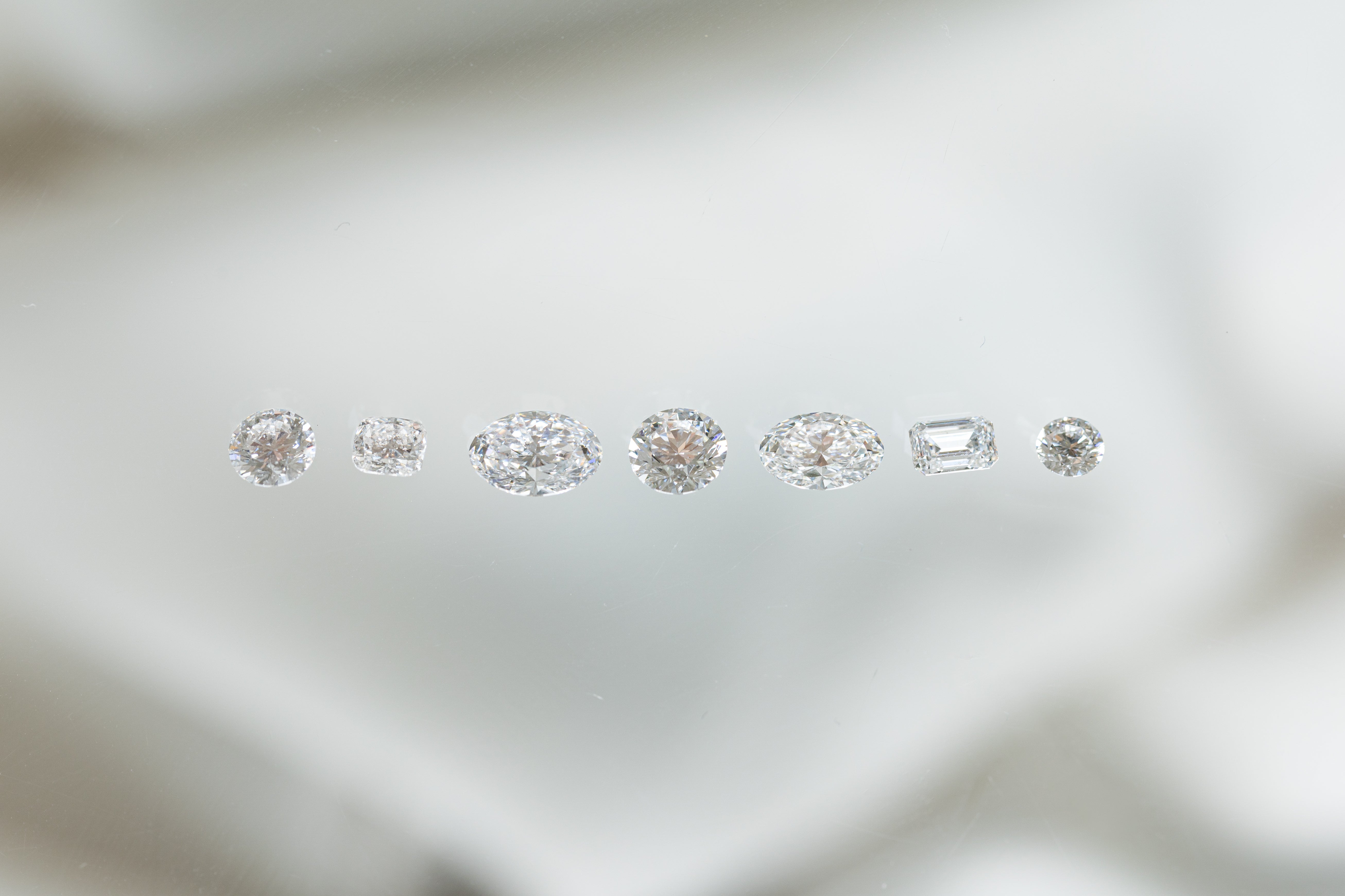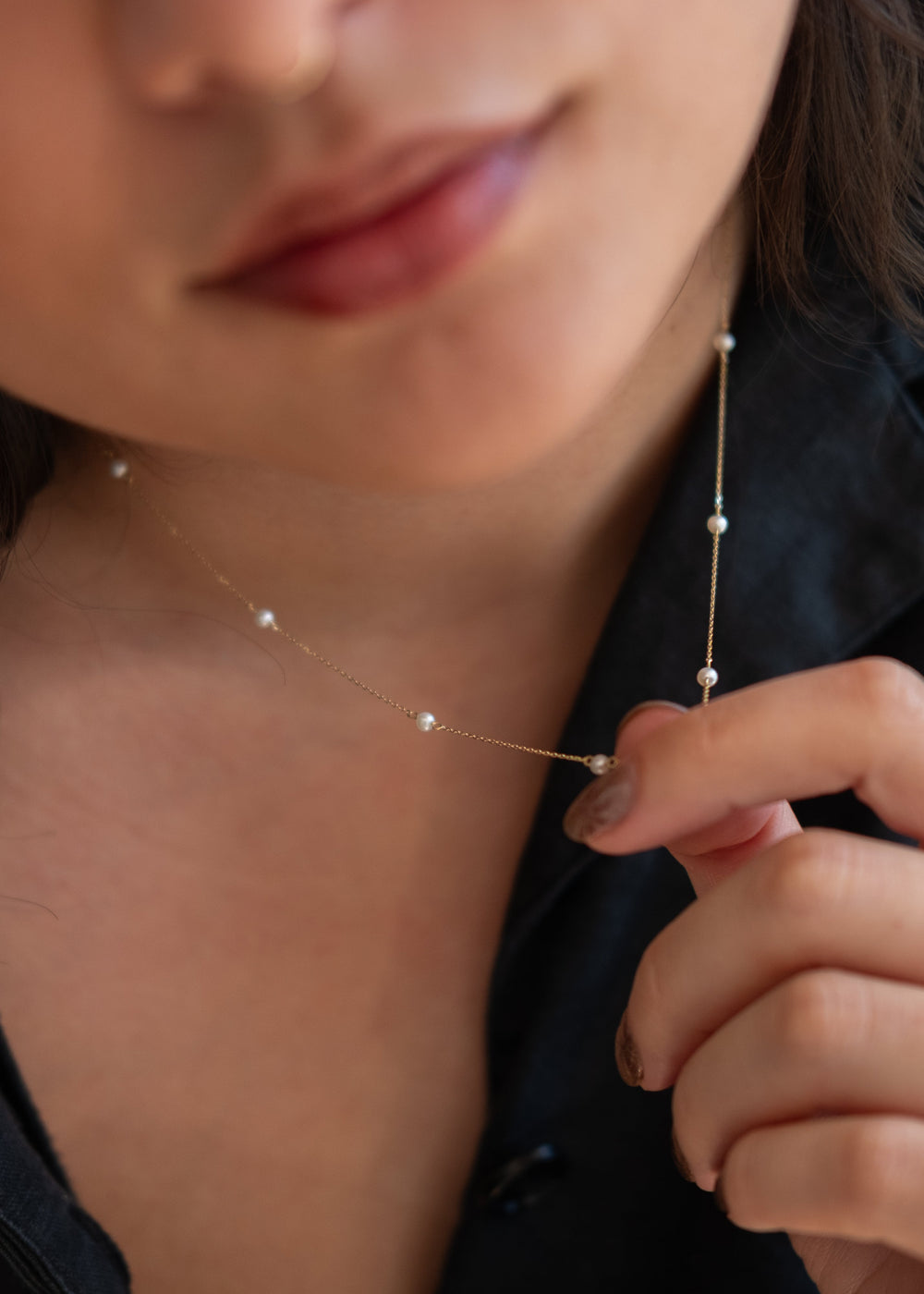Precious gemstones come in every colour of the rainbow, with differences in hue, vibrance, and saturation to match—each with their own unique beauty and symbolism. The standard way to organize gemstones is by species, but for those not familiar, it is useful to categorize gemstones by their colour (or lack of!)
We’ve curated this guide based on our own precious gemstone stock, and recommendations for those who are interested in colourless stones. We strive to work with gemstones that are suitable for daily wear.
Natural Diamond
Natural diamond is a mineral formed deep within the Earth's mantle under extreme pressure and temperature conditions. They are a unique mineral, since they are composed of a single element: carbon. Trace elements found within the diamond can have an effect in its appearance, namely the colour and clarity.
These carbon atoms are arranged in a crystal lattice structure, which is what gives diamonds their extreme hardness and durability. For reference, graphite is also composed of purely carbon, but it is soft enough to write with!
Several factors influence the appearance and value of a natural diamond, including its cut, colour, clarity, and carat weight. If you haven’t heard of this before, this is the 4 C’s. In 1953, the GIA standardized the grades of cut, colour, carat, and clarity.
Cut: The cut refers to the shape of the diamond, as well as its faceting pattern. However, it also determines how well the diamond can reflect light. Diamonds can be graded Excellent, Very Good, Good, Fair, and Poor. The GIA Diamond Cut Grading System considers brightness, fire, and scintillation—which are appearance-based aspects. However, there is more to the cut of a stone: weight ratio, durability, polish, and symmetry—these are all related to a diamond's design and craftsmanship! See below for a more detailed explanation of these terms:
- Brightness is the total light reflected from a diamond (and back into the observer's eye).
- Fire is the dispersion of light into its spectral colours (rainbow sparkle!).
- Scintillation is the pattern of light and dark areas and the flashes of light, or sparkle, when a diamond is moved.
- Weight Ratio will determine how well a diamond displays its weight. A poorly cut diamond will hold unnecessary weight, which will increase the cost without adding a greater visual impact!
- Durability will indicate if any areas of the diamond have been cut in a way that are cause for concern. Areas that have been cut too thin will affect the durability of your diamond.
- Polish refers to the quality of how the facets have been cut. A diamond with excellent polish will have no abrasions, or lines on the facets from where it was cut.
- Symmetry: A diamond that has been cut with excellent symmetry will have an even display of fire, scintillation, and fire.
Clarity: Diamonds have internal features, called inclusions, and surface irregularities, called blemishes. These are referred to in the trade as "clarity characteristics". Clarity simply refers to how clear, or inclusion-free a diamond is. Today, their 6-category, 11-level Clarity Scale is used as an industry standard way to determine the level of imperfections within a diamond.
Colour: Many people think of diamonds as completely colourless. In reality, truly colourless diamonds are very rare. Most diamonds used in jewellery are nearly colourless with yellow or brown tints—most often light yellow. Diamonds graded beyond this scale are labelled as "fancy." Diamonds can also come in other extremely rare colours, such as pink, blue, green, etc, which are also labelled "fancy" diamonds.
Carat: The carat weight refers to the weight of the diamond as opposed to its dimensional size. For your reference, a metric carat, which is 1.0ct, is one-fifth (0.200) of a gram. Diamonds are typically priced per carat, and you will often see a pricing jump at certain specific carat weights (i.e. 0.25ct, 0.5ct, 1.0ct, 1.5ct, etc). In the trade, these are called "magic sizes".
Lab-grown Diamonds
Lab-grown diamonds, also known as synthetic diamonds, are physically, chemically, and visually the same as natural diamonds. The difference being, natural diamonds are formed within the Earth, and lab diamonds are created in controlled laboratory environments using advanced technology that replicates the natural diamond growth process.
Lab-grown diamonds are most commonly made using two methods: High Pressure High Temperature (HPHT) and Chemical Vapor Deposition (CVD). In the HPHT method, a small natural diamond "seed" is placed in a carbon source and subjected to extreme pressure and temperature, allowing the diamond to grow layer by layer. In the CVD method, a natural diamond "seed" is placed in a chamber filled with carbon-rich gases, which are ionized to create a plasma that deposits carbon atoms onto the seed, allowing the diamond to grow. The lab-grown diamond will have the same colour and clarity as the natural diamond seed it came from!
Lab diamonds are often favoured as a sustainable and ethical alternative to mined diamonds. They are identical in chemical composition, physical properties, and optical characteristics to natural diamonds. Lab diamonds are also significantly less expensive than natural diamonds, making them an excellent option for someone seeking a high-quality gemstone for a more affordable price.
Moissanite
In its natural form, Moissanite is an extremely rare mineral. It was first discovered by French chemist, Henri Moissan in a meteor crater in Arizona in the late 19th century. It is composed of silicon carbide, and is known, like diamonds, for its exceptional brilliance and fire.
Moissanite is created in a laboratory setting through a process that mimics the natural formation of the mineral. Silicon carbide crystals are grown under high temperatures and pressure to produce gem-quality moissanite. Unlike lab-grown diamonds, where a "seed" of a natural diamond is used, this is not the case for Moissanite, making each one completely identical to each other in terms of colour and clarity.
Moissanite is offered at an approachable price point, and is typically the least expensive option of the three gemstones we're considering today. Moissanite is also a very durable gemstone, ranking at a 9.25 (second only to diamond) on the Mohs scale of hardness. This makes it an excellent choice for engagement rings.
Moissanites have a higher refractive index ( 2.65 to 2.69) than diamonds (2.42), which means they actually exhibit more brilliance. They also have a higher dispersion, giving them their characteristic rainbow sparkle. Here at Evorden, we offer the Forever One moissanite by Charles & Colvard, which comes with a certificate of authenticity and a Charles & Colvard limited lifetime warranty.
White Sapphire
Sapphires are made of the mineral corundum. While sapphires are often known for their blue colour, they actually come in every colour except red (that's when they're rubies!) White sapphires are a colourless stone, loosely resembling the appearance of a diamond. White sapphires have a lower refractive index (1.77) and exhibit a far more glass-like quality than diamond or moissanite, meaning you are more likely to be able to see directly through the stone and into its setting.
White sapphires are still an excellent choice for engagement jewellery, ranking an 8 on the Mohs scale of hardness. While sapphires are a durable choice, they often require more cleaning to maintain their brilliance than diamond or moissanite. This is primarily due to their glass-like appearance and lower refractive index, which by nature will show more dirt and debris. To clean your ring at home, use warm water, and a drop of dish soap on a toothbrush. Gently scrub around your stone, making sure to reach under the setting. From there, simply rinse and pat dry. White sapphires are offered at an affordable price point, while still offering beauty and durability. However, it is important to keep in mind that white sapphires do not exhibit the same fire and brilliance as diamonds or moissanite, so they may not be the best choice for those seeking maximum sparkle.
Not sure which gemstone is right for you? No problem! Book an appointment to speak with one of our design consultants.
Let us know what other gemstones you would like us to cover next!
- The Evorden Team








Leave a comment